Bed bug populations have exploded universally, particularly in Australia where some estimate there has been a 5000 per cent increase since 2000.
The small parasitic insects feed on human blood and are very mobile, but only travel short distances to feed, which is why they are generally found on beds — hence the name “bed bugs”.
What do bed bugs look like?
Adult bed bugs are 4-6mm in length, oval in shape and a dark reddish brown colour. Juveniles are 1-5mm long, depending on the growth stage, and cream in colour. Eggs are laid at a rate of three per day, are cream in colour, 1mm in length and hatch within 10 days.
Where are they found?
With flat bodies, bed bugs can hide in crevices and cracks, and are not just found on beds. Bed frames, bed-side furniture, picture frames, behind wall paper, behind skirting boards and between floorboards also offer protection for the bugs. They are most commonly found, though, on mattresses, particularly along the stitched edges where there are folds to help conceal them.
What are signs of an infestation?
- Live bed bugs or cast skins.
- Eggs.
- Dark spots of bed bug excrement or blood.
- Bite marks on skin in distinctive lines. These are usually found on the shoulders and arms.
How are bed bugs spread?
Bed bugs can walk short distances between rooms or can be carried over distances on people’s luggage. Bed bugs can survive six months without a meal, so it’s important to look for evidence of an infestation when travelling.
How do I get rid of bed bugs?
The most effective treatment of bed bugs is when chemical and non-chemical treatments are used together. Mildura and District Pest Management can deliver an environmentally-friendly, low toxicity chemical treatment, which when used in conjunction with non-chemical pre-treatments can eradicate your infestation.
To prepare for treatment your house must be vacated for four hours and all bedding must be carried to the washing machine in plastic bags and then washed in hot water.
The important thing to remember is that the treatment takes time so floors should not be cleaned for two to three weeks.
Call Mildura and District Pest Management on (03) 5024 6929 to organise your bed bug treatment today.




